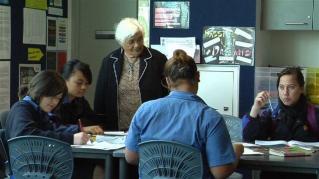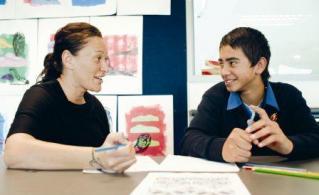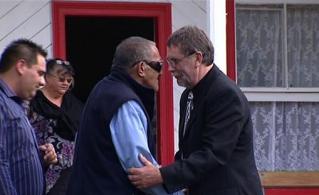Section navigation
School leaders as agents of change
Taihape Area School Case Study: School structure
This clip focuses on a major organisational change that the principal has instigated across the school. Find out what the change is, how it has been made, why it has been made, and its apparent impact (especially on student engagement and achievement).
Think about:
- What the organisational (timetabling) changes at the school actually look like and why they have been made
[“There are three parts to our school day. You break for morning tea, you break for lunch and then you come in the afternoon … It’s not a big change from what you have to do in real life.”
“Whole-day options … in subjects like hip hop, skiing, kayaking … The options come from the aspirations and dreams of students within the school.”]
- What challenges for teachers the timetabling changes have created
[“You couldn’t flick out the same plans, because what worked for 55 minutes didn’t work for an hour and a half.”]
- How the changes have benefited students.
[Stronger engagement in learning: “Student attendance at school has improved dramatically. One of the reasons for this is the way school days are structured”; “It’s lots of fun and it helps … There’s different ways for us to learn … You get a whole day of things that you really enjoy.”
Stronger links to the key competencies and the life skills needed by students: “The options are all about self-discipline, thinking, planning. They fit in really well with the key competencies … They’re really encouraging our students to communicate, to connect … It’s wonderful training for tertiary … and for the work environment.”
Note the Te Kahua facilitator’s observation about links between the key competencies and the core values developed by the school: “We fit the key competencies into the values of Māori rather than the other way around.
Stronger relationships between teachers and students. Note the student observation that “the teachers want to help us achieve now. It’s not just a job … Teachers are much more positive now.”]
- How the changes have helped to foster stronger school-family-iwi-whānau partnerships
[“The structure is helping us utilise community resources … It’s about relationships and communicating with whānau … It’s not just about the teachers, and the teachers have all that knowledge … Students are giving back to the community what the community has given to them.”]
- How the changes (provision of curriculum options) have strengthened teacher practices in core programmes
[“Teachers got to look at what they were teaching and how they were teaching it and how best to engage the students. From this, they got to know the students better and therefore were teaching more to the students’ needs, and this made a big difference … Option days were a lot of hands-on practical work amongst the theory. It made teachers think they should be doing that sort of thing in their normal classroom programmes”; “It’s about the teacher tailoring the learning for the student rather than making the learning try and fit the student.”]
Taihape Area School Case Study: Lessons learnt
This clip summarises the principal’s thinking about how a school can undertake a programme of change, what is important in such a programme, and a leader’s role in promoting and leading such a programme.
Note, in particular, important points made about strategising for change, taking time to make change, using student engagement and achievement evidence as touchstones for making change, and full involvement of all stakeholders in change. Note also the principal’s thinking about the links between change processes and the inquiry process.
Note too the principal’s summary statement about the programme of change that the school undertook:
“The big thing I learnt is that changing the pedagogy is a slow process and it’s teachers that make the difference. If they’re not making a difference, then they have to look at what they’re doing. We strategically got them to examine what they were doing and that was delivering subjects or trying to teach a curriculum and how they were doing that … and then we gradually got them to move from that to looking at what were they doing about learning. Once they were handling that alright … then we moved to the third and important phase and that’s focusing on the learner.”
Although the change appears to be organisational in nature, its basis stems from curriculum and pedagogy. This leads the principal to believe that “there’s a definite recipe … for change that goes from the teaching of subjects to focusing on the learner and what their needs are … It’s not rocket science.”
He concludes by reminding us that “you have to be in a constant statement of review and reflection.”
Note how he links the concept of a programme of change to the concept of teachers as inquirers (“knowing what’s been done, reflecting on it, making a new plan, acting upon it and then it goes around”). He also links it with the concepts of ‘team work’ and ‘transformative leadership’, which involve teachers, students, and families/whānau/iwi in “leading what they’re doing”, with the principal’s support. He observes that leadership is all about self-leadership and recognises that “that’s where the Māori values of tino rangatiratanga fit so well to our model.”
Finally, note his observation that “there’s a fine line between manipulation and strategic development”. Leading change is about involving people strategically. The leader may know where they wants change to head, but they must get wide agreement on this and be prepared to alter their thinking in the light of good evidence.
School staff interviewed have commented on this principal’s powerful vision for learning and his inclusive but transformative leadership style. A leader needs both a vision and an inclusive approach to working with people to bring about meaningful change.


